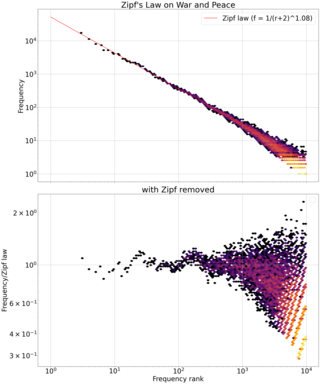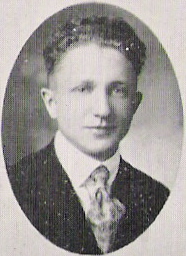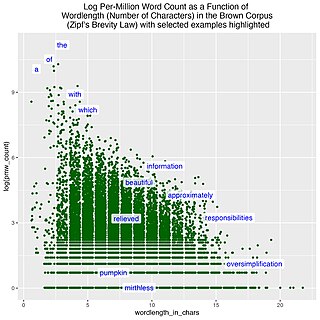Related Research Articles

Zipf's law is an empirical law that often holds, approximately, when a list of measured values is sorted in decreasing order. It states that the value of the nth entry is inversely proportional to n.
In probability theory and statistics, the Zipf–Mandelbrot law is a discrete probability distribution. Also known as the Pareto–Zipf law, it is a power-law distribution on ranked data, named after the linguist George Kingsley Zipf who suggested a simpler distribution called Zipf's law, and the mathematician Benoit Mandelbrot, who subsequently generalized it.
Uses and gratifications theory (UGT) is an approach to understanding why and how people actively seek out specific media to satisfy specific needs. UGT is an audience-centered approach to understanding mass communication. Diverging from other media effect theories that question "what does media do to people?", UGT instead focuses on "what do people do with media?" It postulates that media is a highly available product and the audiences are the consumers of the same product.

George Kingsley Zipf, was an American linguist and philologist who studied statistical occurrences in different languages.
The uncertainty reduction theory, also known as initial interaction theory, developed in 1975 by Charles Berger and Richard Calabrese, is a communication theory from the post-positivist tradition. It is one of the few communication theories that specifically looks into the initial interaction between people prior to the actual communication process. The theory asserts the notion that, when interacting, people need information about the other party in order to reduce their uncertainty. In gaining this information people are able to predict the other's behavior and resulting actions, all of which according to the theory is crucial in the development of any relationship.
Social learning is learning that takes place at a wider scale than individual or group learning, up to a societal scale, through social interaction between peers. It may or may not lead to a change in attitudes and behaviour.
Information seeking is the process or activity of attempting to obtain information in both human and technological contexts. Information seeking is related to, but different from, information retrieval (IR).
Mooers's law is a comment about the use of information retrieval systems made by the American computer scientist Calvin Mooers in 1959:
An information retrieval system will tend not to be used whenever it is more painful and troublesome for a customer to have information than for him not to have it.
Demographic gravitation is a concept of "social physics", introduced by Princeton University astrophysicist John Quincy Stewart in 1947. It is an attempt to use equations and notions of classical physics, such as gravity, to seek simplified insights and even laws of demographic behaviour for large numbers of human beings. A basic conception within it is that large numbers of people, in a city for example, actually behave as an attractive force for other people to migrate there. It has been related to W. J. Reilly's law of retail gravitation, George Kingsley Zipf's Demographic Energy, and to the theory of trip distribution through gravity models.
E-learning theory describes the cognitive science principles of effective multimedia learning using electronic educational technology.
The School of Communication and Information (SC&I) is a professional school within the New Brunswick Campus of Rutgers, The State University of New Jersey. The school was created in 1982 as a result of a merger between the Graduate School of Library and Information Studies, the School of Communication Studies, and the Livingston Department of Urban Journalism. The school has about 2,500 students at the undergraduate, masters, and doctoral levels, and about 60 full-time faculty.

In Internet culture, the 1% rule is a general rule of thumb pertaining to participation in an internet community, stating that only 1% of the users of a website actively create new content, while the other 99% of the participants only lurk. Variants include the 1–9–90 rule, which states that in a collaborative website such as a wiki, 90% of the participants of a community only consume content, 9% of the participants change or update content, and 1% of the participants add content.
The lazy user model of solution selection (LUM) is a model in information systems proposed by Tétard and Collan that tries to explain how an individual selects a solution to fulfill a need from a set of possible solution alternatives. LUM expects that a solution is selected from a set of available solutions based on the amount of effort the solutions require from the user – the user is supposed to select the solution that carries the least effort. The model is applicable to a number of different types of situations, but it can be said to be closely related to technology acceptance models.

Human–computer interaction (HCI) is research in the design and the use of computer technology, which focuses on the interfaces between people (users) and computers. HCI researchers observe the ways humans interact with computers and design technologies that allow humans to interact with computers in novel ways. A device that allows interaction between human being and a computer is known as a "Human-computer Interface (HCI)".
Information behavior is a field of information science research that seeks to understand the way people search for and use information in various contexts. It can include information seeking and information retrieval, but it also aims to understand why people seek information and how they use it. The term 'information behavior' was coined by Thomas D. Wilson in 1981 and sparked controversy upon its introduction. The term has now been adopted and Wilson's model of information behavior is widely cited in information behavior literature. In 2000, Wilson defined information behavior as "the totality of human behavior in relation to sources and channels of information".
Collaborative information seeking (CIS) is a field of research that involves studying situations, motivations, and methods for people working in collaborative groups for information seeking projects, as well as building systems for supporting such activities. Such projects often involve information searching or information retrieval (IR), information gathering, and information sharing. Beyond that, CIS can extend to collaborative information synthesis and collaborative sense-making.
In user interface design and software design, the principle of least astonishment (POLA), also known as principle of least surprise, proposes that a component of a system should behave in a way that most users will expect it to behave, and therefore not astonish or surprise users. The following is a corollary of the principle: "If a necessary feature has a high astonishment factor, it may be necessary to redesign the feature."
Wilson's model of information seeking behaviour was born out of a need to focus the field of information and library science on human use of information, rather than the use of sources.
Diane Kelly is an American computer scientist, notable for her work on the analysis of information seeking behaviours, and the development of experimental methods to support further research in the field. She is director of the faculties of Information Sciences and Communication & Information at the University of Tennessee Knoxville. Kelly's work is strongly user-oriented, with human behaviour and interaction at the centre of her research. She received a simultaneous PhD in Information and Library Science and Cognitive Science Certificate from Rutgers University in 2004. She graduated with an MLS from Rutgers in 1999 and a BA in Psychology & English from the University of Alabama in 1996.

In linguistics, the brevity law is a linguistic law that qualitatively states that the more frequently a word is used, the shorter that word tends to be, and vice versa; the less frequently a word is used, the longer it tends to be. This is a statistical regularity that can be found in natural languages and other natural systems and that claims to be a general rule.
References
- ↑ Bierbaum, Esther: "A Paradigm for the ‘90s", American Libraries, 21(1): 18.
- ↑ Ferrero, G., 1894. L’inertie mentale et la loi du moindre effort. Revue Philosophique de la France et de l’Étranger 37, 169–182.
- ↑ George Kingsley Zipf (1949), Human behavior and the principle of least effort, Addison-Wesley Press
- ↑ Karen E. Fisher (2005), Theories of information behavior, p. 6, ISBN 978-1-57387-230-0
- ↑ Mann, Thomas (1987). A guide to library research methods. Mazal Holocaust Collection. New York: Oxford University Press. ISBN 0195049438. OCLC 15164335.
- ↑ Zao Liu and Zheng Ye (Lan) Lang. "Factors Influencing Distance-Education Graduate Students' Use of Information: A User Study", Journal of Academic Librarianship, 30(1), 2004.